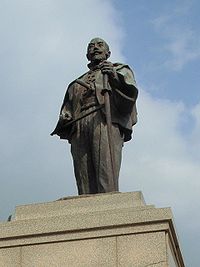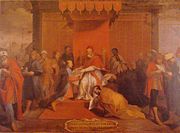
Otomo Sorin
Encyclopedia

Japan
Japan is an island nation in East Asia. Located in the Pacific Ocean, it lies to the east of the Sea of Japan, China, North Korea, South Korea and Russia, stretching from the Sea of Okhotsk in the north to the East China Sea and Taiwan in the south...
ese feudal lord (daimyo
Daimyo
is a generic term referring to the powerful territorial lords in pre-modern Japan who ruled most of the country from their vast, hereditary land holdings...
) of the Ōtomo clan
Otomo clan
The Ōtomo clan was a Japanese clan whose power stretched from the Kamakura period through the Sengoku period, spanning over 400 years. The clan's hereditary lands lay in Kyūshū....
, one of the few to have converted to Christianity
Christianity
Christianity is a monotheistic religion based on the life and teachings of Jesus as presented in canonical gospels and other New Testament writings...
. The eldest son of Ōtomo Yoshiaki, he inherited the domain of Funai, on Kyūshū, Japan's southernmost main island, from his father. He is perhaps most significant for having appealed to Toyotomi Hideyoshi to intervene in Kyūshū against the Shimazu clan
Shimazu clan
The were the daimyō of the Satsuma han, which spread over Satsuma, Ōsumi and Hyūga provinces in Japan.The Shimazu were identified as one of the tozama or outsider daimyō clans in contrast with the fudai or insider clans which were hereditary vassals or allies of the Tokugawa clan,The Shimazu were...
, thus spurring Hideyoshi's Kyūshū Campaign
Kyushu Campaign
The Kyūshū Campaign of 1586-1587 was part of the campaigns of Toyotomi Hideyoshi who sought to dominate Japan at the end of the Sengoku period...
of 1587.
In addition to unifying much of Kyūshū under his control, and securing a significant gain in his clan's power and prestige therefore, Sōrin is also quite significant as one of the daimyo to meet personally, in 1551, with the Jesuit missionary Francis Xavier
Francis Xavier
Francis Xavier, born Francisco de Jasso y Azpilicueta was a pioneering Roman Catholic missionary born in the Kingdom of Navarre and co-founder of the Society of Jesus. He was a student of Saint Ignatius of Loyola and one of the first seven Jesuits, dedicated at Montmartre in 1534...
, one of the first Europe
Europe
Europe is, by convention, one of the world's seven continents. Comprising the westernmost peninsula of Eurasia, Europe is generally 'divided' from Asia to its east by the watershed divides of the Ural and Caucasus Mountains, the Ural River, the Caspian and Black Seas, and the waterways connecting...
ans in Japan. Though he later formally converted to Christianity, it is likely that Sōrin saw this as a strategic move, politically, and was not religiously motivated towards this position. Referred to as the "King of Bungo
Bungo Province
was a province of Japan in eastern Kyūshū in the area of Ōita Prefecture. It was sometimes called , with Buzen Province. Bungo bordered Buzen, Hyūga, Higo, Chikugo, and Chikuzen Provinces.-History:...
" in the Jesuit records, Sōrin sent political delegations to Goa
Goa
Goa , a former Portuguese colony, is India's smallest state by area and the fourth smallest by population. Located in South West India in the region known as the Konkan, it is bounded by the state of Maharashtra to the north, and by Karnataka to the east and south, while the Arabian Sea forms its...
in the 1550s, and the Tenshō embassy to Rome
Rome
Rome is the capital of Italy and the country's largest and most populated city and comune, with over 2.7 million residents in . The city is located in the central-western portion of the Italian Peninsula, on the Tiber River within the Lazio region of Italy.Rome's history spans two and a half...
in 1582.

Usa, Oita
' is a city located in Ōita Prefecture, Japan. Usa is famous for being the location of the Usa Shrine, built in 725, the head shrine of all of Hachiman shrines in Japan.Usa is made up of three areas.*Usa, the area surrounding the Usa Shrine...
five years later; in 1557 he defeated Akizuki Kiyotane and seized Chikuzen Province
Chikuzen Province
was an old province of Japan in the area that is today part of Fukuoka Prefecture in Kyūshū. It was sometimes called , with Chikugo Province. Chikuzen bordered Buzen, Bungo, Chikugo, and Hizen Provinces....
. In 1561, Ōtomo Sōrin fought in alliance with the Portuguese at the Siege of Moji
Siege of Moji
The was a 1561 siege against the castle of Moji in Japan. The castle belonged to the Mōri clan, whose capital was the city of Yamaguchi.Forces under Ōtomo Sōrin attacked the castle in alliance with the Portuguese, who provided three ships between 500 and 600 tons, with 300 crews and 17 or 18...
.
In 1562, Yoshishige adopted the name "Sanbisai Sōrin" upon becoming a Buddhist monk, but remains best known as Ōtomo Sōrin, despite converting to Christianity under the baptismal name Francisco in 1578. He then turned against the Mōri
Mori clan
The Mōri clan was a family of daimyō, descended from Ōe no Hiromoto and established themselves in Aki Province. Their name was derived from a shōen in Mōri, Aikō District, Sagami Province. The generation of Hiromoto began to name themselves Mōri.After the Jōkyū War, Mōri was appointed to the jitō...
and Shimazu clans, who dominated most of Kyūshū.
The head of the Mōri at that time, Mōri Takamoto
Mori Takamoto
was a daimyo of Aki Province during Japan's Sengoku period. He was the eldest legitimate son of Mōri Motonari.-Life:Born in Tajihi, Aki province, Takamoto was sent at the age of 14 to Suo province as a hostage of Ōuchi Yoshitaka. This was done to ensure his father's loyalties to Ōuchi...
, was assisted by the Shōgun Ashikaga Yoshiteru
Ashikaga Yoshiteru
, also known as Yoshifushi or Yoshifuji, was the 13th shogun of the Ashikaga shogunate who reigned from 1546 to 1565 during the late Muromachi period of Japan. He was the eldest son of the 12th shogun, Ashikaga Yoshiharu; and his mother was a daughter of Konoe Taneie...
, which led to a peace treaty between the clans. To prove that there would be peace, Sōrin proposed his daughter to be married to Takamoto's son, Mōri Terumoto
Mori Terumoto
Mōri Terumoto , son of Mōri Takamoto and grandson and successor of the great warlord Mōri Motonari, fought against Toyotomi Hideyoshi but was eventually overcome, participated in the Kyūshū campaign on Hideyoshi's side and built Hiroshima Castle, thus essentially founding Hiroshima.Terumoto was a...
. It is not clear, however, if this offer was ever followed through.

Akizuki clan
The Akizuki clan is a Japanese noble family from prehistoric age. In the Sengoku period, the Akizuki clan was a king of samurai on Japanese "Akizuki-country" in the Kyūshū island. From after the Sengoku period to end of the World War II, the Akizuki family was a Japanese contemporary noble again...
of Chikuzen province. The Ōtomo then moved against the Ryūzōji clan
Ryuzoji clan
The was a Japanese clan which claimed descent from Fujiwara Hidesato. It came to prominence in the Sengoku period, in the fighting in northern Kyūshū. Their descendants became retainers of the Matsudaira clan of Aizu, and remained there until the Meiji Restoration...
of Hizen Province
Hizen Province
was an old province of Japan in the area of Saga and Nagasaki prefectures. It was sometimes called , with Higo Province. Hizen bordered on the provinces of Chikuzen and Chikugo. The province was included in Saikaidō...
, which prompted the interference of the Mōri. In 1569, Hetsugi Akitsura
Tachibana Dosetsu
, born Hetsugi Akitsura, was a Japanese samurai of the Sengoku period who served the Ōtomo clan. He was the father of Tachibana Ginchiyo and adopted father of Tachibana Muneshige.-Biography:...
, a notable vassal of the Ōtomo, was defeated at the battle of Tatarahama
Battle of Tatarahama (1569)
The 1569 battle of Tatarahama was part of the struggles between the Ōtomo and Mōri samurai clans during Japan's Sengoku period, for control of the island of Kyūshū....
, and lost Tachibana Castle
Tachibana castle
was a Japanese castle in Chikuzen Province, in the north of Kyūshū; it is located at the peak of Tachibana Mountain, extending in part into the Higashi-ku in Fukuoka...
. After Sōrin heard of this, he threatened the Mōri foothold in Buzen Province
Buzen Province
was an old province of Japan in northern Kyūshū in the area of Fukuoka Prefecture and Ōita Prefecture. It was sometimes called , with Bungo Province. Buzen bordered on Bungo and Chikuzen Provinces....
, forcing the Mōri to retreat, and allowing him to retake the castle. By this time, Sōrin was in control of Bungo
Bungo Province
was a province of Japan in eastern Kyūshū in the area of Ōita Prefecture. It was sometimes called , with Buzen Province. Bungo bordered Buzen, Hyūga, Higo, Chikugo, and Chikuzen Provinces.-History:...
, most of Buzen, Chikuzen
Chikuzen Province
was an old province of Japan in the area that is today part of Fukuoka Prefecture in Kyūshū. It was sometimes called , with Chikugo Province. Chikuzen bordered Buzen, Bungo, Chikugo, and Hizen Provinces....
, Chikugo
Chikugo Province
is the name of a former province of Japan in the area that is today the southern part of Fukuoka Prefecture on Kyūshū. It was sometimes called , with Chikuzen Province...
, and had influence over Higo and Hizen. The Ōtomo soon became known as the "Seven-Province Host of the Ōtomo".

Ryuzoji clan
The was a Japanese clan which claimed descent from Fujiwara Hidesato. It came to prominence in the Sengoku period, in the fighting in northern Kyūshū. Their descendants became retainers of the Matsudaira clan of Aizu, and remained there until the Meiji Restoration...
, he appealed to Toyotomi Hideyoshi to aid in holding back the Shimazu, who were beginning to extend their influence over Ōtomo and Ryūzōji lands. Though at first unsuccessful in enlisting Hideyoshi's aid, eventually the Shimazu took up arms against the Ōtomo, defeated Sōrin in the Battle of Mimigawa
Battle of Mimigawa
The Battle of Mimigawa was a battle, fought in Japan, between warlords Tawara Chikataka and Shimazu Yoshihisa in 1578. The Shimazu clan, following their conquest of the Hyuga Province, began to mobilize their armies and prepare for another attack. Meanwhile, the Tawara clan saw this as a threat and...
and others, and in 1587, Hideyoshi began his Kyūshū Campaign, in which he overtook the entire island, with the help of the Ōtomo and other families which voluntarily entered his service.
Within roughly a year of his arrival, Hideyoshi left Kyūshū, restoring the Ōtomo to their domains, taken from them by the Shimazu, and arranging a peace, with all three families officially subject to Hideyoshi and holding the domains, now officially Toyotomi lands, in trust. Ōtomo Sōrin died before this campaign was complete, and so it was his son, Ōtomo Yoshimune, who held the ancestral lands upon the defeat of the Shimazu.

